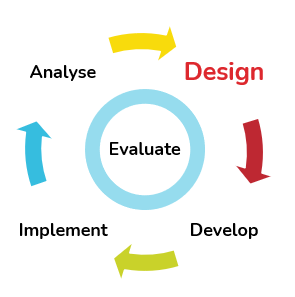2. Design your course
Approaches to design
Now you have a clear idea of your audience and what you want them to achieve in your training, you can start designing activities to enable this to happen. You are now at the Design stage of the ADDIE framework.
When thinking about design there are many methods you can follow. We have chosen the ABC-Learning Design (ABD-LD) method developed by University College London, as it’s quick, simple and well tested! This method will introduce different learning activity types and take you through storyboarding your learner’s journey.
But before we go any further, let’s recap some of the key principles from the introductory video:
Bloom’s taxonomy
defines different levels of learning, starting with remembering, understanding, applying, analysing, evaluating and creating.
We’ll talk about the different types of learning activities shortly, but we’ll start with thinking about how you will evaluate and assess different aspects of your training.